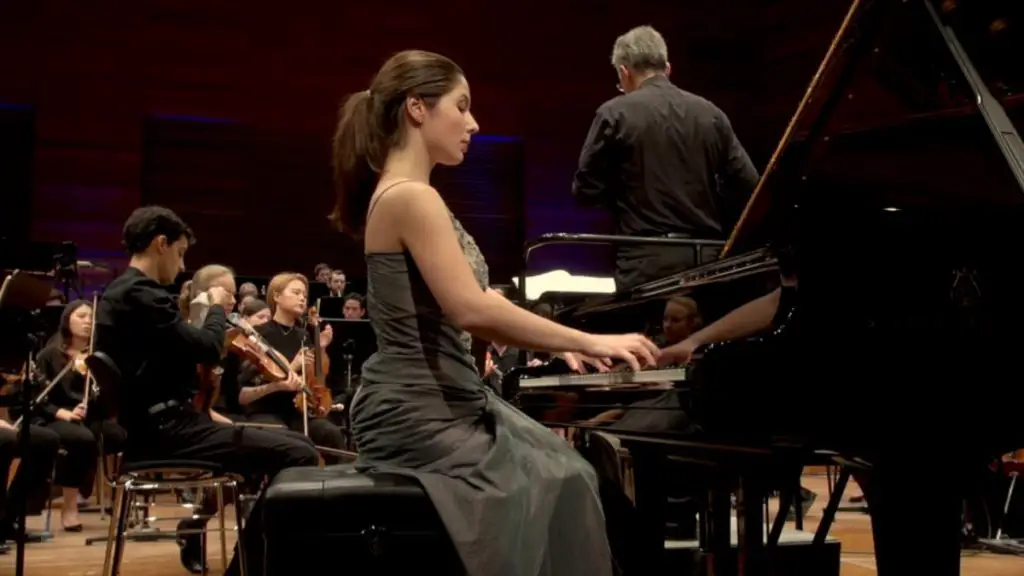Accompanied by the London Philharmonic Orchestra, Vladimir Ashkenazy performs Ludwig van Beethoven’s Piano Concerto No. 5 in E-flat major, Op. 73, popularly known as the “Emperor Concerto”. Conductor: Bernard Haitink. Recorded at the Royal Festival Hall in London in 1974.
Ludwig van Beethoven’s Piano Concerto No. 5
Beethoven wrote this concerto, which is his last piano concerto between 1809 and 1811 in Vienna, and dedicated it to Archduke Rudolf (8 January 1788 – 24 July 1831, a Cardinal, an Archbishop of Olmütz, and a member of the House of Habsburg-Lorraine), his patron and pupil.
The title “Emperor” was not given by Beethoven himself but was likely coined by the English publisher of the concerto. It reflects the grandeur and heroic spirit that pervade the music, which many listeners have associated with the qualities of an enlightened ruler. Unlike Beethoven’s earlier piano concertos, which follow the classical traditions of Mozart and Haydn, the “Emperor” Concerto breaks new ground in scale, structure, and musical content.
Piano Concerto No. 5 opens with a striking and innovative introduction where the piano plays a series of powerful chords, setting the stage for a work that combines virtuosic brilliance with deep lyrical passages. The interplay between the solo piano and the orchestra is more integrated than in his earlier concertos, showcasing Beethoven’s maturing compositional style. The orchestration is lush and expansive, supporting the soloist without overwhelming the intricate and expressive piano part.
Throughout the concerto, there is a sense of struggle and triumph, a reflection perhaps of Beethoven’s personal adversities, particularly his increasing deafness. This concerto was the first that Beethoven was unable to perform himself due to his hearing loss, marking a significant turning point in his life and career.
Beethoven’s Piano Concerto No. 5 is scored for a solo piano, two flutes, two oboes, two clarinets in B-flat (clarinet 1 playing clarinet in A in movement 2; flute 2, clarinet 2, both trumpets, and timpani are tacet during this movement), two bassoons, two horns, two trumpets, timpani in E-flat and B-flat, and strings.
There are three movements:
- Allegro in E-flat major. Despite its use of simple chords, including a second theme constructed almost entirely out of tonic and dominant notes and chords, the first movement is full of complex thematic transformations. When the piano enters with the first theme, the expository material is repeated with variations, virtuoso figurations, and modified harmonies. The second theme enters in the unusual key of B minor before moving to B major and at last to the expected key of B-flat major several bars later. Following the opening flourish, the movement follows Beethoven’s trademark three-theme sonata structure for a concerto. The orchestral exposition is a typical two-theme sonata exposition, but the second exposition with the piano has a triumphant virtuoso third theme at the end that belongs solely to the solo instrument (Beethoven does this in many of his concertos). The coda at the end of the movement is quite long, and, again, typical of Beethoven, uses the open-ended first theme and gives it closure to create a satisfying conclusion.
- Adagio un poco mosso in B major. The second movement in B major is calmly paced and delicate, being a standard contrast to the first movement. It moves into the third movement without interruption when a lone bassoon note B drops a semitone to B-flat, the dominant note to the tonic key E-flat.
- Rondo. Allegro ma non-troppo in E-flat major. The final movement of the concerto is a seven-part rondo form (ABACABA), a typical concerto finale form. The piano begins the movement by playing its main theme, followed by the full orchestra. The rondo’s B-section begins with piano scales before the orchestra again responds. The C-section is much longer, presenting the theme from the A-section in three different keys before the piano performs a cadenza. Rather than finishing with a strong entrance from the orchestra, however, the trill ending of the cadenza dies away until the introductory theme reappears, played first by the piano and then by the orchestra. In the last section, the theme undergoes variation before the concerto ends with a short cadenza and robust orchestral response.
![Beethoven: Piano Concerto No. 5 [Zimerman, Bernstein, Wiener Philharmoniker]](https://cdn-0.andantemoderato.com/wp-content/uploads/2023/04/Beethoven-Piano-Concerto-No-5-Zimerman-Bernstein-Wiener-Philharmoniker-1024x567.jpg)
Sources
- Piano Concerto No. 5 (Beethoven) on Wikipedia
- Piano Concerto No. 5, Op.73 (Beethoven, Ludwig van) on the International Music Score Library Project website
